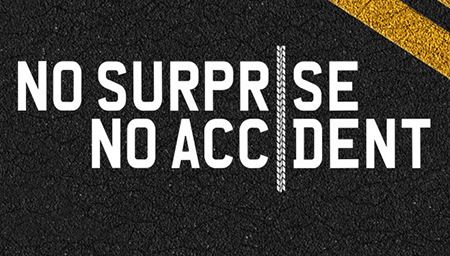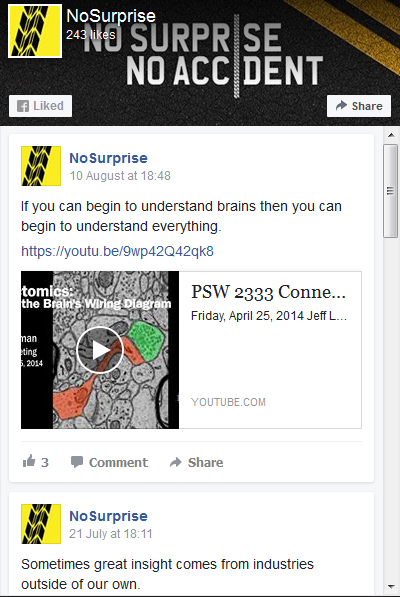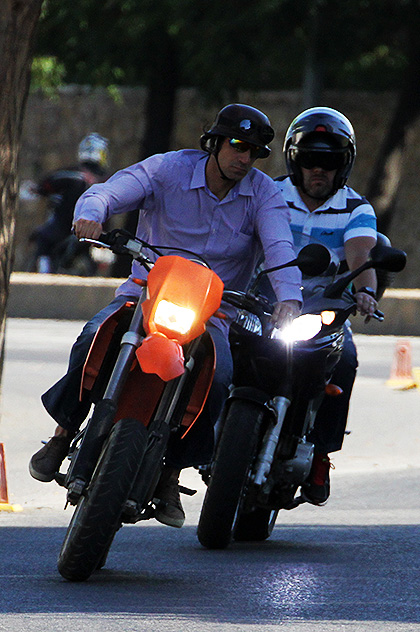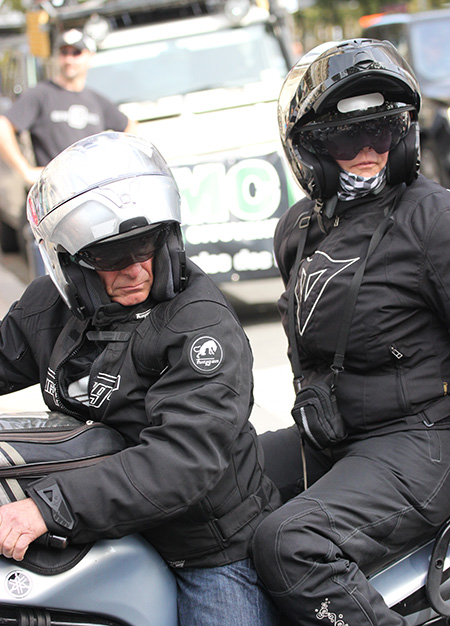 United Kingdom – “All accidents are the result of prediction failure. Surprise is Nature’s way of telling us we have experienced such a failure. If there is no surprise, there can be no accident”
United Kingdom – “All accidents are the result of prediction failure. Surprise is Nature’s way of telling us we have experienced such a failure. If there is no surprise, there can be no accident”
The aim of the ‘No Surprise? No Accident!’ campaign is to reduce the number of motorcycle crashes by shifting the way we think about road safety.
No Surprise? No Accident! argues that we need new and original thinking to tackle old problems, a new paradigm for motorcycle safety.
Take the time to read through the article below. At times it may seem a bit heavy going but to understand a ‘new’ way of thinking needs a bit of thinking to understand it!
Perfectly Normal And Controlled Ride
For a long time, it’s been assumed that if we teach people to achieve a suitable level of skill and then ensure they conform to a set of rules, they won’t crash.
From that perspective, it’s easy to assume that those people who do crash must have either have inadequate skills, have broken the rules or both.
Typical descriptions of crashes use phrases like ‘lost control’ or ‘too fast for the conditions’.
But a moment’s logical thinking shows there’s a problem with this description of the event. Quite clearly, the rider was ‘in control’ and ‘wasn’t too fast for the conditions’ a mile back up the road or they would have crashed there instead. Indeed, throughout their entire journey they were in control and not too fast for the conditions, right up to the precise point they crashed.
So what changed at the point of the crash? What turned a perfectly normal and controlled ride at a pace that was entirely suitable for the conditions into a nightmare of twisted metal and pain?
To answer this question, let’s look at what we do know already.
What Do We Know Already?
 We know WHERE motorcyclists crash because the majority of crashes involving motorcycles happen in the same places over and over. Just think about the two most common crashes; the collision with a turning car and the rider who crashes on a bend.
We know WHERE motorcyclists crash because the majority of crashes involving motorcycles happen in the same places over and over. Just think about the two most common crashes; the collision with a turning car and the rider who crashes on a bend.
We know WHY people crash – an inappropriate response at the important moment, whether that’s changing speed or changing direction in the wrong way, or failing to make an input when one was needed.
And we also know WHO crashes. In many cases, it’s riders who were actually trained to make the right inputs for an emergency. Emergency stops have been part of rider training for decades and for the last few years riders have been trained and tested on their ability to swerve too.
And we also know that in many cases those crashes were avoidable. So why don’t riders employ their crash avoidance skills when they need them? For years, that’s been the question that’s not been addressed although US motorcycle racer and coach Keith Code provided a big chunk of the answer two decades ago when he talked about what he called ‘Survival Reactions’ in his book ‘Twist of the Wrist 2’, which he explained how riders react to emergencies with inappropriate responses including target fixation, freezing on the steering, and locking a wheel by grabbing a big handful of brake.
Surprise Derails Our Brains
The trigger for these inappropriate reactions must happen in the last few and crucial seconds as the rider perceives the developing situation ; in fact, at the point where choosing the right input would prevent a crash.
The logical step forward that ‘No Surprise’ has made is to identify that trigger.
An important point here is to understand how perform complex tasks and how we process the information that comes in to our brain in real-time.
Wherever possible, tasks are handled by pre-learned and automated routines that allow us to perform complex tasks like driving below the level of our consciousness. This goes way beyond the very fast mechanical responses we sometimes call ‘muscle memory’ but also allow for choices between different strategies in response to the situations in which we find ourselves. These are the intuitive decisions where we just ‘know’ what to do.
One part of our brain filters incoming data from our various senses. It compares that incoming data stream with data streams that we have experienced before and stored in memory. Should the incoming data appear to match scenarios that have already been successfully negotiated, then our brain automates the task by running the program that is the best fit for what it sees, a program that it’s learned by experience has worked in similar situations in the past.
Remember learning to catch? In the very earliest stages of learning this very complex perceptual/motor task we had to work out just how to judge the flight of the ball and then time our own movement to intercept it. Initially we weren’t very good at it at all, but as we gained more experience of how the ball travels through time and space we were able to catch the ball much more easily as our brain developed an program which controlled our muscles without conscious input. And catching practice allows us to experience catching the ball at the end of a variety of different trajectories, which steadily reduces the chance of the ball’s flight being something novel.
So if someone shouts “catch”, we look round to and prepare to track the ball in the air, and then move in a way to make a controlled catch.
That’s a learned response, and it’s thanks to these learnt responses we can perform these tasks without conscious thinking. The way we learn to catch a ball is exactly the same as the way we learn to process tasks as we ride the bike. Learning through repetition and practice reduces the potential novelty of a situation and as a result reduces the potential for something surprising to happen.
But should our brain detect anything novel in the incoming data, then it hands the problem up to our real-time, thinking brain, where we consciously start thinking about the novelty, deciding whether or not that novelty represents a threat and deciding how we’re going to deal with it if it does.
A key factor which prevents a correct response turns out to if our EXPECTATION of how the situation will develop turns out to be at odds with how it ACTUALLY develops. A rider is at serious risk of an accident when they continue to do what they normally do in a particular situation unaware that the precise circumstances in which they are about to find themselves are very far from the ‘usual’ state of affairs. The problem is that right up to the last second, the abnormal circumstances that precipitate a crash nearly always appear to be very similar to the normal ones we were expecting.
And so what happens isn’t what we were expecting. And the result is Surprise!
The Reptilian Brain

Think what we do if someone unexpectedly throws a ball at our head – we duck or put a hand up to protect our face without any conscious thought. But this isn’t our learned catching routine; a child will do the same. It’s actually the response of a much older bit of the brain, which automatically kicks in if there’s an immediate threat of personal harm. This primitive part of the brain is sometimes called the ‘reptilian brain’ and controls our ‘fight or flight’ reactions.
Entirely beyond our conscious control, the reptilian brain is always alert to deal with threats that are beyond the capability of both our learned responses and our real-time, thinking neo-cortex to manage. The problem is that reptiles don’t ride motorbikes and its attempts to prevent personal harm are behind Keith Code’s inappropriate ‘survival reactions’ and they are NOT good for our bike control.
Understanding just what triggers the reptilian brain to take over is a second key fact in ‘No Surprise? No accident!’ It’s the event that we DIDN’T predict, the event that is novel and unexpected, the event that surprises us is that is likely to result in our reptilian brain taking over.
Surprise derails our brain’s learned and automated responses and if our real-time, thinking brain can’t come up with a quick plan to deal with the threat, then the reptilian brain takes over and traps us into making those inappropriate responses that Keith Code identified.
Surprise and Predication Failure
‘Prediction failures’ occur when there is a discrepancy between what we predicted was going to happen and thus prepared for, and how the situation actually developed over last few seconds before things went wrong. The bigger the gulf between the scenarios we were mentally prepared for and the scenario actually experienced, the less chance we have of preventing our reptilian brain taking over with some inappropriate action.
But simply looking at motorcycle crashes shows that we have been having the same crashes since Gottlieb Daimler first stuck a engine in a bicycle frame. There are very few one-off crashes.
Why?
Humans are Creatures of Habit
We are creatures of habit, and our habits tend to narrow down to “what worked yesterday will work today”. And mostly, we don’t crash. Paradoxically, it’s likely that the longer the interval between prediction failures, the more we come to trust our prediction skills and the less we actively predict the ‘worst case scenario’.
This isn’t complacency or over-confidence but a basic function of the way our brain processes experience. The longer we ride and the longer nothing untoward happens, the more our brain will rely on that prior experience and the more likely we are to think that nothing will happen next time we go riding either. That means it’s very difficult to stay focused on staying out of trouble, and this can happen despite the best intentions of the rider to try to ride defensively. We go mentally stale.
The UNreasonable Event
 And riders are not routinely taught to ‘expect the unexpected’. In fact, the UK Police system states we should plan for “what we can see, what we can’t see and what we can REASONABLY expect to happen”. The problem is that it’s the UNreasonable events that catch us out.
And riders are not routinely taught to ‘expect the unexpected’. In fact, the UK Police system states we should plan for “what we can see, what we can’t see and what we can REASONABLY expect to happen”. The problem is that it’s the UNreasonable events that catch us out.
Take the case of the classic junction collision as an example of how a rider can assume the situation is normal (car won’t pull out) when in fact it is abnormal (car will pull out). It is knowing and identifying the tiny differences in circumstances that change the situation from normal to abnormal that will guide the rider’s predictions and help them avoid a collision.
Rather than assuming that the car will wait until a rider is past the junction what the rider could do instead is to see if the car has somewhere to go to should the driver decide to pull out. If there is a space for them to pull out into, then that is the clue that the situation could be about to deviate from the normal (car won’t pull out) to the abnormal (car will pull out).
Remembering that car drivers involved in collisions are also doing normal things (pulls out when road is clear) in abnormal circumstances (pulls out without seeing bike) helps to identify those situations that if a bike were normally absent a car would normally pull out.
Professor Erik Hollnagel is an internationally recognised specialist in the fields of resilience engineering, system safety, human reliability analysis, cognitive systems engineering, and intelligent man-machine systems. He is the author of more than 500 publications including twenty-two books, articles from recognised journals, conference papers, and reports.
These quotes from Professor Hollnagel encapsulate the thinking behind the idea of No Surprise? No Accident!
“If the imagination is insufficiently rich to capture what can actually happen, i.e., if the variety (richness) of the imagination is less than the variety (richness) of actual events, then there will be surprises. The larger the difference is, the more surprises there will be.”
“Most of us have a fairly naive understanding of probabilities. We tend to believe that the most probable thing will happen and are surprised every time it does not. We tend to forget two things. First that the most probable thing to happen is not the only possible thing to happen. Second, that even if something is very improbable, then it is still possible that this improbable something may happen.”
Our suggestion? Simple ‘Rhyming Reminders’
If there is a job description for the rider, it is that they should be able to “predict with 100% certainty what’s going to happen next”.
To achieve that goal of predicting what is going to happen next, we believe that motorcyclists need to be better equipped to detect the onset of abnormal circumstances so that they can make much better informed predictions and decisions about how to manage them and that take all possible steps to ensure that the reptilian brain never gets the opportunity to take control.
We believe a simple way of achieving this is to create ‘Simple Rhyming Reminders’, easy-to-remember mnemonics, which help to mentally re-program a rider so that they can easily identify the abnormal or ‘worst case’ scenario.
For example “Cango?-Willgo!” is a Simple Rhyming Reminder to help riders remember to check to see if a car waiting to turn at a junction CAN turn, because if it is ABLE to turn, it MIGHT turn in front of the rider.
Another example Simple Rhyming Reminder example to help riders when filtering to remember that vehicle might emerge or turn across their path is “Gaps?=Traps!”.
Simple Rhyming Reminders lay no blame. They judge neither the rider, nor other road users, nor even the environment. They are simple, memorable and factual reminders that will help all riders to make better predictions about “what happens next” and avoid being surprised.
And if there is No Surprise? Then there is No Accident!
No Surprise – No Accident – On Facebook


Leave a Reply